
Is AI Writing Impossible to Detect?
And here we go! The 21st century makes a sharp turn and stops over an advancement that turns the entire system of education and creative work upside down. It is funny that it is even referred to as a post-plagiarism era with the emergency of Chat GPT and other tools like that. However, plagiarism has not disappeared. Instead, it got to a new level never experienced before. There is no more certainty about the originality of any text, piece of music, photo, or even picture. In the age of AI, ethical issues over plagiarism and using non-human generated content are major concerns for researchers, professors, music critics, and art lovers. This hot topic makes everyone discuss artificial intelligence ethics and struggle for transparency in all spheres. Still, the thing is that it is a huge challenge to determine whether a certain piece of writing, for example, is generated by a machine not a person. Even if it is done, the degree of certainty never goes up to 100 % and that causes problems and a great mess.
Is Using AI Plagiarism in Academics Easy to Detect?
College and university instructors are in mass technological panic and it stands to reason. Still, the same happened when school students got access to calculators or Internet in their smartphones. Can google detect AI content? Are there any software tools to check papers not for old-fashioned copy-pasting but for using smart machines that do the writing themselves? Teachers keep asking questions and look for all possible means of checking the essays they get from their students. Although AI-tools can be helpful assistants in learning, they also contribute to global academic dishonesty as the students no longer complete their assignments without cheating.
While the issue of AI in search engines is under investigation, all major plagiarism detection companies, such as PlagiarismSearch.com, Turnitin, and others have launched more or less sophisticated tools to identify AI-generated writing. Others have also introduced some services which are supposed to flag high likelihood of using AI not human efforts in writing. Hurray, this is a solution! Hold on, there is a great problem with all that. Research in this field is a must, but unfortunately, there is not much clarity or certainty in the results of such detection.
Challenges of Detecting AI-Powered Plagiarism
Artificial intelligence is a very dynamic field which keeps developing every new day or even hour. What can actual testing show? In most cases, it only covers the issues with AI which exist at the moment. In fact, you can never be absolutely sure that the text is generated either by a human or AI. When it goes about conventional checking, PlagiarismSearch.com, for instance, produces a report with all matchings highlighted and a professor may click on the links and verify the plagiarism, analyzing the texts.
It is not that simple for an AI plagiarism checker. It does not rely on any sources to compare with the text. Thus, what you get is a percentage of likelihood not a definite positive or negative answer. If you see that it is ‘highly likely’ that the passage is AI-generated, it is not the same as to get a solid proof of plagiarism. Even 98% of report accuracy does not guarantee that there is no mistake in the verdict. False positives may be destructive for a student’s reputation, being a genuine threat for the system comparable with the AI itself.
We Are Playing a Game of Probabilities
What makes the ethics of AI issues even more controversial is that AI itself is used for identification of plagiarism. That is a great paradox which has its own advantages and disadvantages.
Advantages:
- AI does scanning of huge amounts of information to guarantee a considerable degree of precision in detecting plagiarism.
- AI checks are cost-effective.
- The entire process takes a few seconds only.
- The results of plagiarism check are consistent and that ensures academic integrity, although
- AI is one of the sources of plagiarism itself.
Disadvantages:
- Some of the plagiarism check results may be falsely positive. Even if the text is original, it may be flagged as plagiarized.
- AI does not take into account the context.
- In the texts with abundant terms or specialized vocabulary, an AI plagiarism checker sometimes finds it difficult to identify actual plagiarism, especially if the language is not English.
Strategies of Detecting AI-Generated Content
Despite the continuous enhancements in the AI tools, there are certain strategies used to distinguish between the human-written and AI-generated texts. Some of them are below:
- Identifying repetitions
The same ideas and even structures may be used a number of times throughout the text.
- Checking for inconsistencies
The tone and style of writing may be abruptly changed without a solid reason for that.
- Looking for uncommon vocabulary
AI language may differ from natural one as the tool makes an unusual choice of words and structures.
- Specifying limited use of sources
AI may refer only to some specific databases and websites. This particular choice of sources may be a feature that flags AI use.
AI ethics and Prospects for the Future
Online resources have made it much easier for people to plagiarize, but AI has opened a new era in the sphere of academic integrity. You can copy any information from the Internet, but that can be traced by plagiarism search tools. AI writing has started a new game with new rules and it is really sophisticated to make them effective. What if a new approach combines a human-driven and a technological strategy? It seems that it can guarantee much better efficiency of checks and certainty of results.
What can teachers do to eliminate the chances of AI plagiarism in students’ papers? Modifying original texts, AI systems do overlapping the layers of information to conceal all traces of non-originality.
Is chat gpt plagiarism? Yes, it is! Can we identify the text generated by it with 100% certainty? Not really! Still, the things will definitely change. All technologies keep developing and hopefully, one day there will be a tool capable of giving a definite answer to the question about the use of AI in writing. Otherwise, there will be a lot of ethical concerns in all spheres of life.



